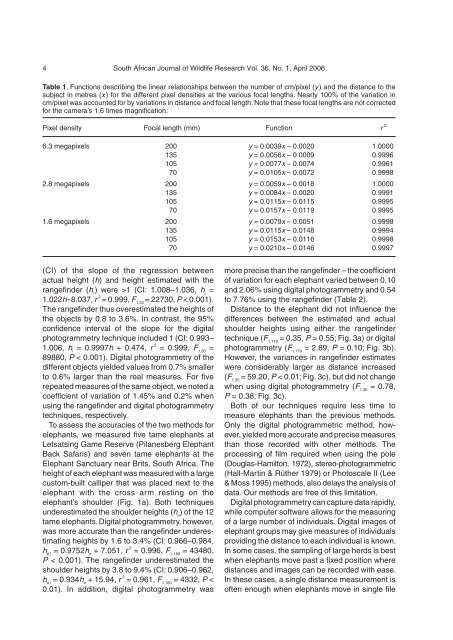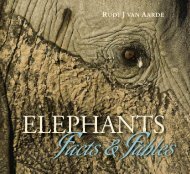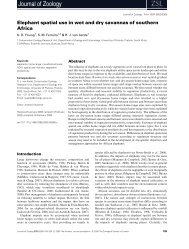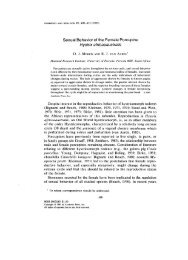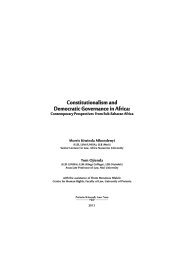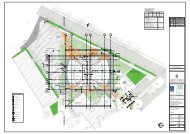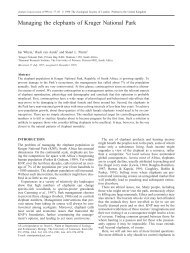Digital photogrammetry and laser rangefinder techniques to ... - CERU
Digital photogrammetry and laser rangefinder techniques to ... - CERU
Digital photogrammetry and laser rangefinder techniques to ... - CERU
You also want an ePaper? Increase the reach of your titles
YUMPU automatically turns print PDFs into web optimized ePapers that Google loves.
4 South African Journal of Wildlife Research Vol. 36, No. 1, April 2006<br />
Table 1. Functions describing the linear relationships between the number of cm/pixel (y ) <strong>and</strong> the distance <strong>to</strong> the<br />
subject in metres (x ) for the different pixel densities at the various focal lengths. Nearly 100% of the variation in<br />
cm/pixel was accounted for by variations in distance <strong>and</strong> focal length. Note that these focal lengths are not corrected<br />
for the camera’s 1.6 times magnification.<br />
Pixel density Focal length (mm) Function r 2<br />
6.3 megapixels 200 y = 0.0039x – 0.0020 1.0000<br />
135 y = 0.0056x – 0.0009 0.9996<br />
105 y = 0.0077x – 0.0074 0.9961<br />
70 y = 0.0105x – 0.0072 0.9998<br />
2.8 megapixels 200 y = 0.0059x – 0.0018 1.0000<br />
135 y = 0.0084x – 0.0020 0.9991<br />
105 y = 0.0115x – 0.0115 0.9995<br />
70 y = 0.0157x – 0.0119 0.9995<br />
1.6 megapixels 200 y = 0.0079x – 0.0051 0.9998<br />
135 y = 0.0115x – 0.0148 0.9994<br />
105 y = 0.0153x – 0.0116 0.9998<br />
70 y = 0.0210x – 0.0146 0.9997<br />
(CI) of the slope of the regression between<br />
actual height (h) <strong>and</strong> height estimated with the<br />
<strong>rangefinder</strong> (h i<br />
) were >1 (CI: 1.008–1.036, h i<br />
=<br />
1.022h–8.037, r 2 = 0.999, F 1,33<br />
= 22730, P < 0.001).<br />
The <strong>rangefinder</strong> thus overestimated the heights of<br />
the objects by 0.8 <strong>to</strong> 3.6%. In contrast, the 95%<br />
confidence interval of the slope for the digital<br />
<strong>pho<strong>to</strong>grammetry</strong> technique included 1 (CI: 0.993–<br />
1.006, h i<br />
= 0.9997h + 0.474, r 2 = 0.999, F 1,30<br />
=<br />
89880, P < 0.001). <strong>Digital</strong> <strong>pho<strong>to</strong>grammetry</strong> of the<br />
different objects yielded values from 0.7% smaller<br />
<strong>to</strong> 0.6% larger than the real measures. For five<br />
repeated measures of the same object, we noted a<br />
coefficient of variation of 1.45% <strong>and</strong> 0.2% when<br />
using the <strong>rangefinder</strong> <strong>and</strong> digital <strong>pho<strong>to</strong>grammetry</strong><br />
<strong>techniques</strong>, respectively.<br />
To assess the accuracies of the two methods for<br />
elephants, we measured five tame elephants at<br />
Letsatsing Game Reserve (Pilanesberg Elephant<br />
Back Safaris) <strong>and</strong> seven tame elephants at the<br />
Elephant Sanctuary near Brits, South Africa. The<br />
height of each elephant was measured with a large<br />
cus<strong>to</strong>m-built calliper that was placed next <strong>to</strong> the<br />
elephant with the cross arm resting on the<br />
elephant’s shoulder (Fig. 1a). Both <strong>techniques</strong><br />
underestimated the shoulder heights (h e<br />
) of the 12<br />
tame elephants.<strong>Digital</strong> <strong>pho<strong>to</strong>grammetry</strong>, however,<br />
was more accurate than the <strong>rangefinder</strong> underestimating<br />
heights by 1.6 <strong>to</strong> 3.4% (CI: 0.966–0.984,<br />
h e,i<br />
= 0.9752h e<br />
+ 7.051, r 2 = 0.996, F 1,180<br />
= 43480,<br />
P < 0.001). The <strong>rangefinder</strong> underestimated the<br />
shoulder heights by 3.8 <strong>to</strong> 9.4% (CI: 0.906–0.962,<br />
h e,i<br />
= 0.934h e<br />
+ 15.94, r 2 = 0.961, F 1,180<br />
= 4332, P <<br />
0.01). In addition, digital <strong>pho<strong>to</strong>grammetry</strong> was<br />
more precise than the <strong>rangefinder</strong> – the coefficient<br />
of variation for each elephant varied between 0.10<br />
<strong>and</strong> 2.06% using digital <strong>pho<strong>to</strong>grammetry</strong> <strong>and</strong> 0.54<br />
<strong>to</strong> 7.76% using the <strong>rangefinder</strong> (Table 2).<br />
Distance <strong>to</strong> the elephant did not influence the<br />
differences between the estimated <strong>and</strong> actual<br />
shoulder heights using either the <strong>rangefinder</strong><br />
technique (F 1,179<br />
= 0.35, P = 0.55; Fig. 3a) or digital<br />
<strong>pho<strong>to</strong>grammetry</strong> (F 1,179<br />
= 2.89, P = 0.10; Fig. 3b).<br />
However, the variances in <strong>rangefinder</strong> estimates<br />
were considerably larger as distance increased<br />
(F 1,35<br />
= 59.20, P < 0.01; Fig. 3c), but did not change<br />
when using digital <strong>pho<strong>to</strong>grammetry</strong> (F 1,35<br />
= 0.78,<br />
P = 0.38; Fig. 3c).<br />
Both of our <strong>techniques</strong> require less time <strong>to</strong><br />
measure elephants than the previous methods.<br />
Only the digital pho<strong>to</strong>grammetric method, however,<br />
yielded more accurate <strong>and</strong> precise measures<br />
than those recorded with other methods. The<br />
processing of film required when using the pole<br />
(Douglas-Hamil<strong>to</strong>n, 1972), stereo-pho<strong>to</strong>grammetric<br />
(Hall-Martin & Rüther 1979) or Pho<strong>to</strong>scale II (Lee<br />
& Moss 1995) methods, also delays the analysis of<br />
data. Our methods are free of this limitation.<br />
<strong>Digital</strong> <strong>pho<strong>to</strong>grammetry</strong> can capture data rapidly,<br />
while computer software allows for the measuring<br />
of a large number of individuals. <strong>Digital</strong> images of<br />
elephant groups may give measures of individuals<br />
providing the distance <strong>to</strong> each individual is known.<br />
In some cases, the sampling of large herds is best<br />
when elephants move past a fixed position where<br />
distances <strong>and</strong> images can be recorded with ease.<br />
In these cases, a single distance measurement is<br />
often enough when elephants move in single file


